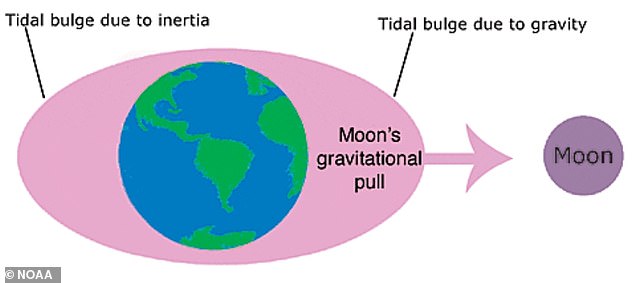Scientists predict Earth days could grow to 25 hours long as our moon drifts further away
New research shows that days on Earth are slowly getting longer as the moon gradually moves away from our planet.
Scientists have discovered that as the moon moves further away from Earth, the changing force of gravity on Earth causes the planet’s rotation to slow and the days to become longer.
They predicted that days on our planet could eventually last 25 hours, but also noted that this would take about 200 million years.
The Moon is slowly but surely moving further and further away from our planet, causing the days on Earth to become longer and longer.
“As the moon moves away, the Earth is like a spinning figure skater slowing down as he extends his arms,” explains Earth scientist Stephen Meyers, a professor at the University of Wisconsin-Madison.
The moon is about 383,000 kilometers away from our planet. A single orbit around the Earth takes about 27.3 days.
However, previous research has shown that the moon is drifting further and further away from us, at a rate of about 3.8 centimeters per year. This means that it will take longer for the moon to move around our planet.
At some point, the Moon will reach a stable distance and only be visible from one side of our planet.
For his study, Meyers and his colleague reconstructed the deep history of the relationship between the Earth and the Moon.
They discovered that 1.4 billion years ago, a day on Earth lasted only 18 hours.
To make this calculation, the researchers devised a statistical method that links astronomical theories to geological observations to look back into the Earth’s geological past.
This allowed them to reconstruct a deep history of the solar system.
Billions of years ago, days on Earth were shorter, mainly because the Moon was closer to our planet.
The researchers concluded that this caused our planet to rotate faster than it does now.
But throughout Earth’s history, the moon has drifted further and further away from us. This process is known as ‘lunar recession’.
We know this because of the astronauts on the Apollo missions. They placed reflectors on the moon, allowing scientists on Earth to fire lasers at the lunar surface and measure exactly how fast the moon was receding.
As the moon slowly slides away, it causes the Earth’s rotation to slow down. The reason for this has to do with the moon’s impact on the ocean tides.
As the Earth rotates, the gravity of the moon orbiting the planet exerts pressure on the oceans, creating high and low tides.
The moon’s gravity causes seawater to “bulge” toward the moon, regardless of which side of the Earth is closest to the moon.
At the same time, inertia tries to hold the water in place. But the moon’s gravity is stronger, causing the water to bulge toward the moon.
On the other side of the Earth, the Moon’s gravity is weaker because that side is further away.

As the moon orbits the Earth, gravity pulls on the ocean, creating bulges around the center of the Earth. This is partly what slows the Earth’s rotation.
There the inertia is stronger than the moon’s gravity, and the water tries to keep moving in a straight line. This causes the water to bulge away from the moon.
The combined gravity and inertia of the moon create two tidal bulges that remain aligned with the moon as the Earth rotates.
But the Earth rotates much faster on its axis than the moon rotates above it. This means that the friction of the ocean basins moving below it also pulls the water along.
So the bulges move slightly ahead of the moon’s orbit, causing the bulges to be pulled backwards.
This gradually slows the Earth’s rotation as the Moon gains energy and moves into a higher orbit around the Earth.
Other factors also influence the Earth’s rotation, including climate change.
As global temperatures rise, polar ice is melting faster than ever before, flooding Earth’s oceans.
All the meltwater gradually moves from the Earth’s poles toward the equator, where the ocean moves toward and away from the moon.
This has caused the Earth to widen even further around the center and slowed its rotation even further.
All of this means that the days on Earth are getting longer. The changes are small enough that we won’t really notice them – they won’t affect our circadian rhythms.
But over millions of years, all those little changes will add up, eventually adding an extra hour to Earth’s daily cycle.
